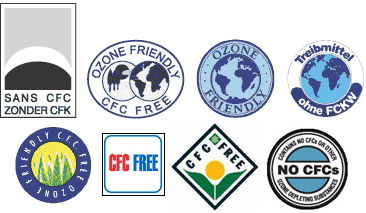Ozone has undoubtedly been present in the earths atmosphere since the beginning, as life on earth can not have existed without incoming UV radiation been absorbed and preventing damage to ecosystems. It has forever been regenerating and being destroyed, by naturally occurring chemicals such as Hydrogen, Bromine and Nitrogen (Solomon, 2010). These chemicals trigger catalytic reactions which break down Ozone into Oxygen and other elements. This has kept ozone levels fairly steady throughout the years, with these elements having naturally occurring variations which were in no way extreme.
Chlorofluorocarbons(CFC's) are created by humans for use in refrigerators, air conditioners and other uses for maintaining temperature. Therefore, did not come into existence until the 20th century. Chlorine atoms are very reactive and leads to one of the reactions which destroy ozone(Solomon et al, 1986), and when CFC's are expose to UV radiation they dissociate and form chlorine atoms which are highly reactive with ozone, diminishing it to Oxygen molecules and ClO (Chlorine monoxide which also reacts with ozone) - do you see the vicious cycle?
The polar vortex creates a beautiful but catastrophic phenomenon called polar stratospheric clouds. As clearly explained by the name, they are present near the poles, especially during their winter, where there is no sunlight for approximately 3 months which means that temperatures reach record lows of -80 degrees Celsius (Poole,1998). It is the conditions present on these clouds which are perfect for the photochemical reactions leading to the break down of ozone. Therefore, the period that this ozone destruction occurs is in the early spring of the antarctic, when there is just enough sunlight for the radiation of UV to be enough to trigger the photochemical reaction which lead to the breaking down of ozone but not enough to melt the clouds and stop the reaction. The presence of the polar stratospheric clouds are why ozone in this area is being depleted so rapidly, and not in other areas (explained in my next blog).
 |
| Figure 1: Polar Stratospheric Clouds |
Even though the antarctic polar vortex confines the depletion of ozone within the area of circulating cold air around the continent(Toon,1991), when the clouds have melted and the reactions are terminated, warm air from lower latitudes intrudes, and the depleted ozone air blows towards the equator, and usually is focused above Australia, and specifically Brisbane(Solomon,2010). The location of Australia near the equator means that not only is there less ozone for the suns rays to travel through, and therefore less is absorbed or reflected, but the sun in this area is also overhead, which is why these areas are at the highest risk for skin cancer (Cancer.org).
 |
| Figure 1 (EPA,2010) |
Contrary to Carbon Dioxide, Ozone concentrations have been observed to have decreased (Figure 1) over the years, and especially since 1980, when CFC use will have started to become very popular. Therefore the negative correlation between CFC's and ozone show us how strong the anthropogenic impact on a crucial element of the earths atmosphere has been.
Just like so much effort is put into decreasing anthropogenic emissions of Carbon Dioxide, it is just as important to minimize CFC usage.
Atmospheric Ozone is a crucial element to the atmosphere. It absorbs UV radiation which can have extremely damaging effects on plants, animals and even humans as mentioned previously. Skin cancer, cataracts and destruction of crops are only a few of the devastating effects that high UV radiation can have.
 |
| Figure 3: CFC free labels from around the world |
No comments:
Post a Comment